Goldfish are considered one of the icon fish available in the aquarium hobby. But, it’s natural to want a thriving community tank full of different species of fish.
To help you find the best goldfish tank mates, I’ve used my knowledge and experience to compile, not only this list of safe and compatible options, but also a set of guidelines you can use to look at any species of fish and know if it will be a suitable tank mate.
14 Best Tank Mates For Your Goldfish
With these established guidelines we’ve set in place for choosing tank mates for your goldfish, let’s go through some of the best options for you.
1. Goldfish (Carassius auratus)

Yes, other goldfish make the best goldfish tank mates. Firstly, goldfish are very social fish and love to be in the company of other goldfish.
Displaying schooling behaviors, goldfish are rarely aggressive towards one another. Even during breeding, males will not become aggressive.
Your only consideration here is the speed and swimming ability of your type of goldfish. For example, you can’t pair comet goldfish with bubble eye goldfish, because comets are too fast and will eat all the food.
Only combine similar body types and swimming characteristics.
2. Rosy Barbs (Pethia conchonius)
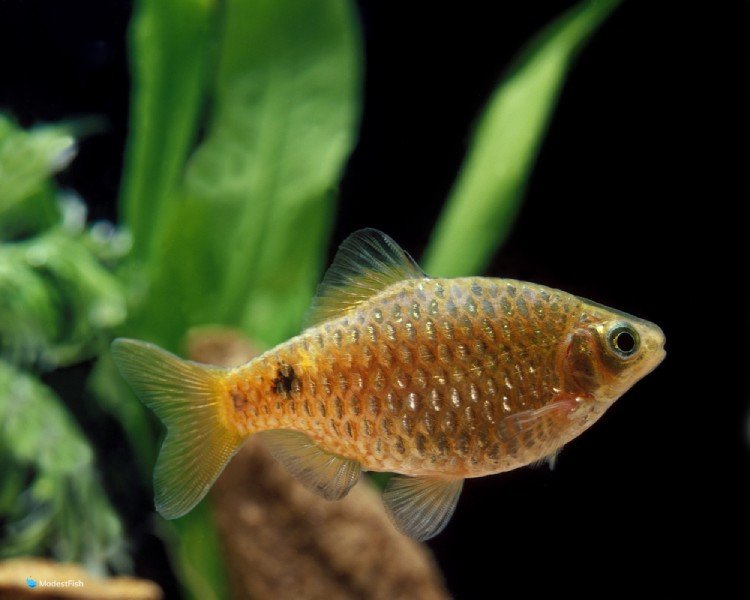
- Care Level: easy
- Temperament: peaceful (must be kept in a group of 5 or more, no exceptions!)
- Size: 6 inches (15 cm)
- Diet: omnivore
- Minimum tank size: 30 gallons (113 liters)
- Temperature: 64°-72°F (18°-22°C)
Rosy barbs and goldfish can work together, but it has to be done just right.
Rosy barbs absolutely need to be kept in a group of five or more. They are a schooling fish and being kept in too small of a group can cause them to be overly aggressive.
The bigger the group of barbs, the more likely they are to just concern themselves with each other rather than the goldies.
Keep an eye on them to watch for fin nipping.
Rosy barbs are cute little fish that shoal together quite well. Most found in the trade are a solid orange-red but there are several other color varieties available.
These little fish are hardy and undemanding. They’re easy keepers that will eat flakes, small pellets and most frozen foods.
They are fast swimmers, so you’ll need to make sure that your goldfish are able to get some food before your barbs swoop in and snatch it all.
Since they top out at 6 inches (15 centimeters), they’re a great size that’s way too big for a goldfish to eat. Just make sure that your tank is large enough since both species will need plenty of room.
3. Zebra Danios (Danio rerio)
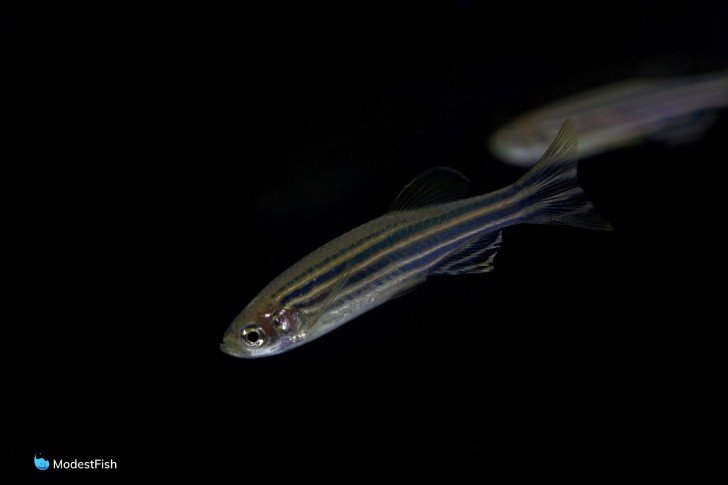
- Care level: easy
- Temperament: peaceful (needs to be kept in a group of 5 or more)
- Size: 2 inches (5 cm)
- Min tank size: 10 gallons (38 liters)
- Diet: omnivore
- Temperature: 65°-75°F (18°-24°C)
Zebra danios are fast moving, tiny fish that can easily tolerate the same temperature range as goldfish. Beware, they are small enough that adult goldfish can eat them.
But, they are extremely quick, much speedier than most goldfish.
It’s a risk to mix these two species, but danios can dart very quickly and should be able to easily outswim a goldy.
Zebra danios are slim-bodied fish with blue and yellow stripes that run from nose to tail. Their bodies are covered in an iridescent sheen that shimmers and catches the light as they dart around the tank.
They would make a great contrast to your goldfish as they rush past in a school.
It would be a good idea to provide the danios with some tall artificial plants so they have a place to hide if needed.
4. Giant Danios (Devario aequipinnatus)
- Care Level: easy
- Temperament: peaceful (must be kept in a group of 5 or more)
- Size: 4 inches (10 cm)
- Diet: omnivore
- Minimum tank size: 30 gallons (113 liters)
- Temperature: 70°-75°F (21°-24°C)
Giant danios are the bigger cousin of the zebra danio. They look very similar, with iridescent blue and yellow stripes running along their bodies, but they are twice the size of zebras.
They are also schooling fish that need to be kept in a group of five or more. If their school is too small, they are likely to become stressed and more aggressive.
It’s a good idea to provide them with tall artificial plants so that they have handy hiding spots if needed.
Giant danios are much faster swimmers than goldfish so you’ll need to make sure the danios don’t outcompete them for food.
Pro Tip: If you have a mixed tank, goldfish can be fed a sinking food while you give top feeding fish something like flake food.
This also keeps goldfish from swallowing air while they eat. This may help prevent swim bladder disorder.
5. White Cloud Mountain Minnows (Tanichthys albonubes)
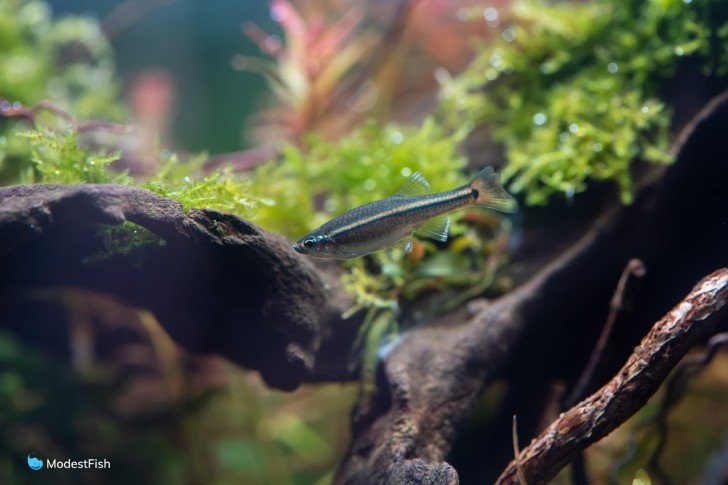
- Care Level: easy
- Temperament: peaceful (should be kept in a group of 5 or more)
- Size: 1.5 inches (4 cm)
- Diet: omnivore
- Minimum tank size: 10 gallons (38 liters)
- Temperature: 64°-72°F (18°-22°C)
White Cloud Mountain minnows are another small fish that will have to rely on speed to keep out of the mouths of hungry goldfish.
This small fish really is an underrated gem in the hobby. They can thrive in the same temperature range as goldies.
They are a slim-bodied fish that has bright red fins and an iridescent stripe that runs from nose to tail. It’s body is a silver color that can shine blue or yellow, depending on the light.
They are a fast moving fish, almost to the point of seeming hyperactive in the extreme. They can outpace any goldfish, which is a good thing considering they are small enough to be swallowed whole.
You’ll likely need to feed your white clouds a different diet since their mouths are tiny compared to goldfish.
6. Dojo Loach (Misgurnus anguillicaudatus)
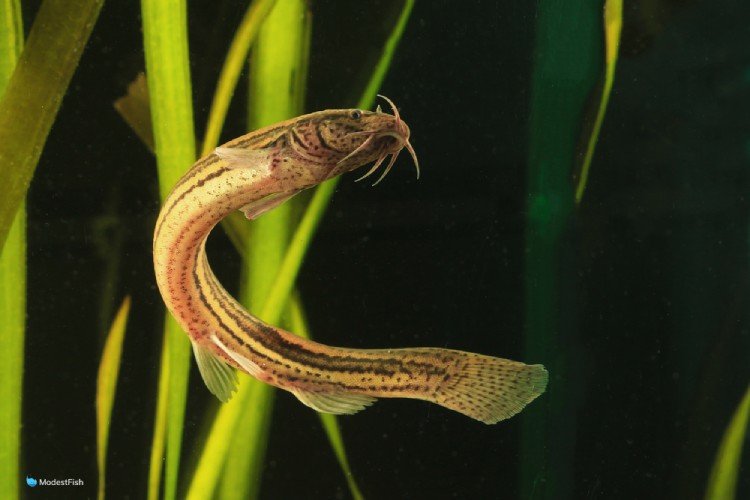
- Care Level: easy
- Temperament: peaceful (should be kept in groups of 3 or more)
- Size: 10-12 inches (25.5-30 centimeters)
- Diet: omnivore
- Minimum tank size: 75 gallons (283 liters)
- Temperature: 65°-75°F (18°-24°C)
If you don’t have at least a 75 gallon tank, just pass on by this species. They are an interesting bottom feeder that is very compatible with goldfish. But they can reach a length of 1 foot (30 centimeters) and should be kept in a group of three or more.
This species is a bit of a tank buster. Put it together with goldfish and you’re talking about a lot of bioload that requires heavy filtration and a strict maintenance schedule.
Dojo loaches (weather loach) has a long eel-like body that is uses to swim in a serpentine motion. This species does a good job of keeping the substrate free of uneaten food as it searches the bottom with its face whiskers (called barbels).
These unusual fish prefer a sand bottom. They like to burrow into the substrate to hide during the day and then they’ll emerge at night to search for food.
7. Banded Corydoras (Scleromystax barbatus)
- Care Level: easy
- Temperament: peaceful (should be kept in groups of 5 or more)
- Size: 4 inches (10 centimeters)
- Diet: omnivore
- Minimum tank size: 30 gallons (113 liters)
- Temperature: 61°-74°F (16°-23°C)
Banded corydoras are a species of South American catfish. They are a highly social fish and should be kept in groups of at least five, more is even better. They are very peaceful.
This species can be a bit difficult to find in live fish stores. However, it’s a good fit for goldfish since it can tolerate the right temperature range and gets up to 4 inches long, much too big for a goldfish to swallow whole.
They have a flat belly, high sloped forehead and a cluster of barbels around their mouths that they use to search the bottom for food. They’re a great little cleaner fish that’s enjoyable to watch in its own right.
8. Platy (Xiphophorus maculatus)
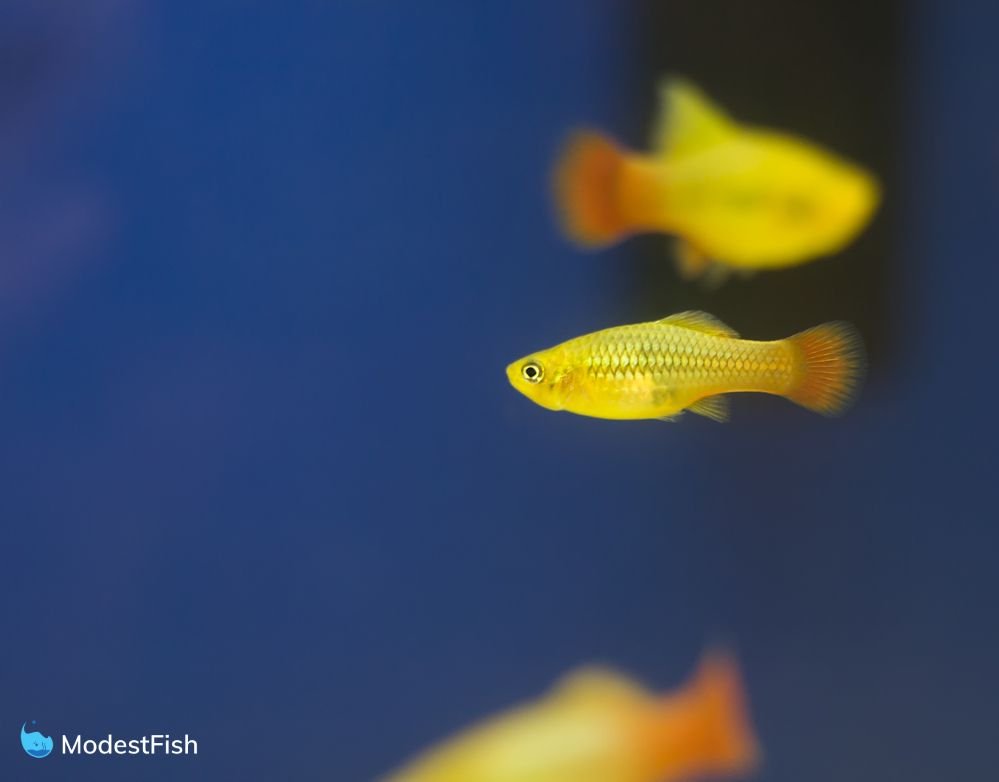
- Care Level: easy
- Temperament: peaceful (should be kept in a ratio of 2 females to 1 male)
- Size: 2.5 inches (6 centimeters)
- Diet: omnivore
- Minimum tank size: 10 gallons (38 liters)
- Temperature: 70°-80°F (21°-27°C)
Platies are generally thought of as a tropical fish, but they can easily thrive in the low 70s along with goldfish.
They are thick-bodied for such a little fish and platies come in a huge variety of patterns and colors.
Platies are livebearers, meaning that they give birth to live young instead of laying eggs. They will readily breed in an aquarium. However, adult fish usually eat the fry unless they are moved to a separate tank.
Juvenile platies may be tempting for goldfish to eat, but they are a very fast moving species that should be able to outswim most species of goldfish. Provide some hiding places with artificial plants and other decor to give your platies a refuge from the goldfish when they need it.
Platies are fast swimmers and voracious eaters so it’s important to make sure that your goldfish are able to get something to eat.
9. Hillstream Loach (Sewellia lineolata)
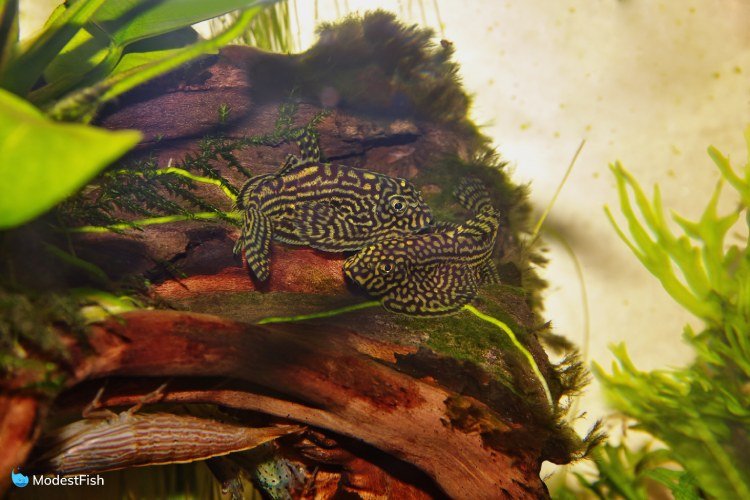
- Care Level: Easy
- Temperament: Peaceful
- Size: 2-3 inches
- Diet: Omnivore
- Minimum tank size: 20 gallon
- Temperature: 65-80°F (20-27°C)
Often confused with catfish, hillstream loaches actually come from the family Balitoridae, and can make an excellent tank mate for your goldfish due to their habits and ability to thrive in lower temperatures.
The main type sold in the aquarium trade is also known as the tiger hillstream or golden ring butterfly sucker.
A wonderful fish to look at, hillstream loaches have evolved to have a streamlined body, flat belly, and horizontal ventral fins (used for clinging to rocks), giving them the appearance of a small stingray.
This species is a bottom-dweller, so will rarely come into direct contact with your goldfish. Spending their days clinging to glass, rocks, plants or driftwood.
Hillstream loaches feed mostly on algae, so don’t need to compete with your goldfish for food and they generally like to stay out of the way.
10. Hog-Nosed Brochis (Brochis multiradiatus)
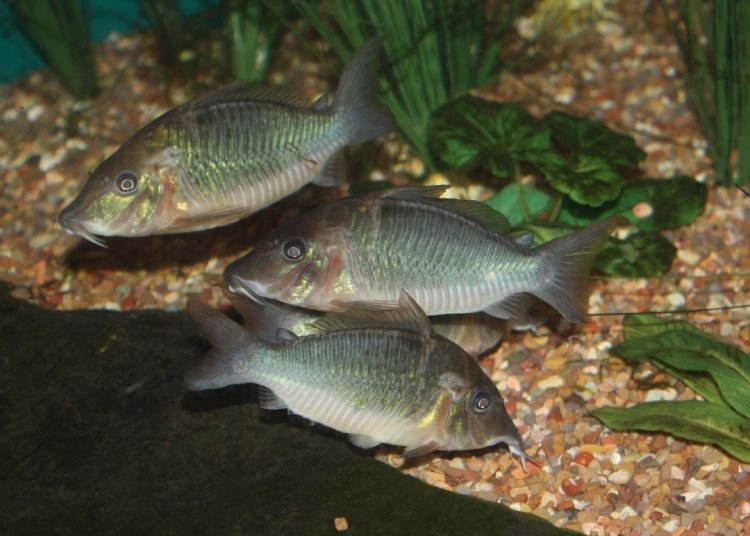
- Care Level: Easy
- Temperament: Peaceful
- Size: 4 inches
- Diet: Omnivore
- Minimum tank size: 30 gallons
- Temperature: 70–75 °F (21–24 °C)
Although a tropical fish, the hog-nosed brochis is able to adapt to temperatures as low as 70°F so it overlaps with your goldfish’s water parameters.
Coming from the Corydoras family, what sets the Brochis apart from common Corys and makes them suitable for a goldfish tank mate is its thick- set body and size (growing up to 4inches).
This size and their spiny dorsal fins means no goldfish is going to try and fit them in their mouths.
These peaceful bottom-dwellers like to spend their time forging through substrate; vacuuming up all the left-over food your goldfish will waste as well as snacking on algae. All in all, the hog-nosed brochis is an excellent addition to a community tank’s “clean-up crew”.
11. Bristlenose Pleco (Ancistrus sp.)
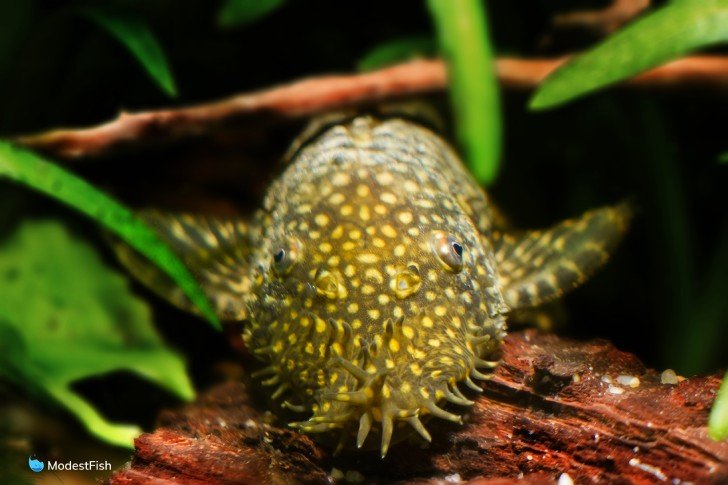
- Care Level: Easy
- Temperament: Peaceful
- Size: 4-6 inches
- Diet: Omnivore
- Minimum tank size: 20 gallons
- Temperature: 73.0 to 81.0° F (22.8 to 27.2° C)
The bristlenose pleco is a favorite amongst hobbyists for community tanks or tank mates in general and this is no expectation when it comes to goldfish.
Also known as bushynose, they have long whiskers and are covered in plate-like scutes to protect them from predators or bully fish. They’re typically a dark brown/black-gray spotted color, but there are more exotic types of pleco.
Bristlenose plecos are easy to care for and adaptable to a wide range of water parameters to match your goldfish. Being bottom-feeders, means they’ll spend their time hoovering up any algae or waste in your tank and rarely bother anything else in your aquarium.
There are stories of plecos feeding on goldfish’s protective slime coat. However, this is often due to the owner of the tank not providing enough food for their pleco. As long as you have some algae wafers, blacked veggies and provide sinking pellets, bristlenose plecos will live peacefully with goldfish.
12. Rubbernose Pleco (Chaetostoma sp.)
- Care Level: Easy
- Temperament: Peaceful
- Size: 4-6inches
- Diet: Omnivore
- Minimum tank size: 20 gallons
- Temperature: 73.0 to 81.0° F (22.8 to 27.2° C)
If you’re not a fan of the bristlenose plecos mustache, but still want a cool looking armored catfish as a goldfish tank mate, the rubbernose pleco might be best for you.
Growing up to 6 inches long, they act just the same; spending their time attached to plants, aquarium glass, rocks or driftwood grazing on algae.
These are peaceful freshwater fish who won’t cause any issues for your goldfish. You may also find this fish under the names: rubber lip pleco, bulldog pleco, spotted rubber pleco.
13. Hoplo Catfish (Megalechis thoracata)
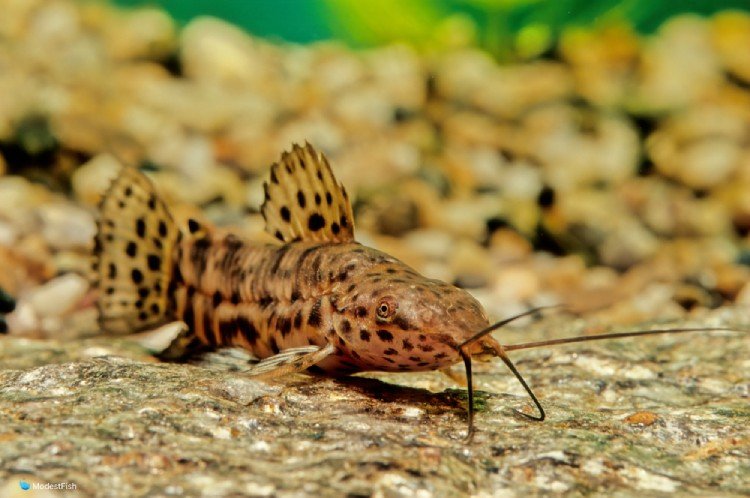
- Care Level: Easy
- Temperament: Peaceful
- Size: 6 inches
- Diet: Omnivore
- Minimum tank size: 55 gallon (for small group)
- Temperature: 64- 82° F (18° – 28° C)
The hoplo catfish is a great option for your goldfish tank if it’s over 55 gallons.
This is a beautiful species of freshwater catfish, with attractive markings, a peaceful nature, and the ability to adapt to a wide range of water conditions.
What’s great about the hoplo compared to other catfish, is it feeds during the day so you get plenty of viewing pleasure. However, they are shy, so if you want to see them at maximum activity, you should keep a group of 4-6.
It’s considerably bigger than other freshwater snails. The enormous shell offers ample protection against hungry and curious goldfish!
The best part of mystery snails is that they can improve the overall condition of the tank. They’re omnivores that eat everything from leftover food to plant detritus and algae! These snails will keep things clean, which is a huge plus.
14. Mystery Snail (Pomacea bridgesii)
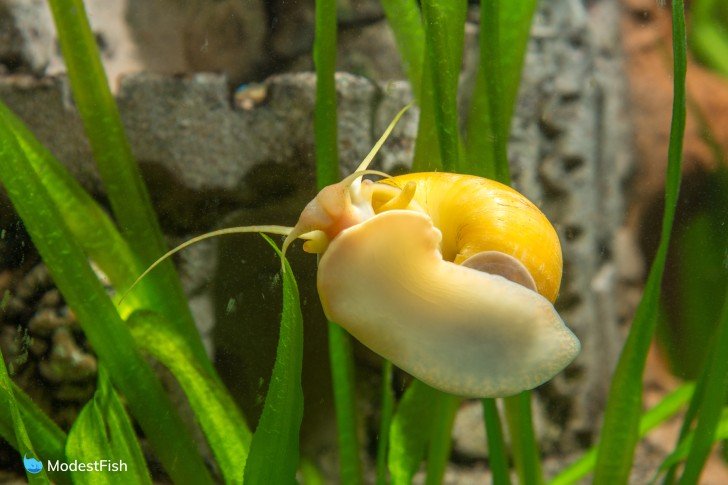
- Care Level: Easy
- Temperament: Peaceful
- Size: 2 inches
- Diet: Omnivore
- Minimum tank size: 5 gallon
- Temperature: 66- 84° F (18° – 28° C)
Snails aren’t always at the top of everyone’s list when it comes to tank mates, but a mystery snail can add some fun personality to your goldfish tank.
They’re super cute to look at, are real busy-bodies in tanks, can adapt to a wide range of water conditions, and are easy to care for.
Mystery snails come in a wide range of colors: black, brown, golden, ivory, albino.
These snails are top-tier algae eaters, but they do an excellent job of eating up organic waste and left over food in your tank.
What Makes An Ideal Goldfish Tank Mate?
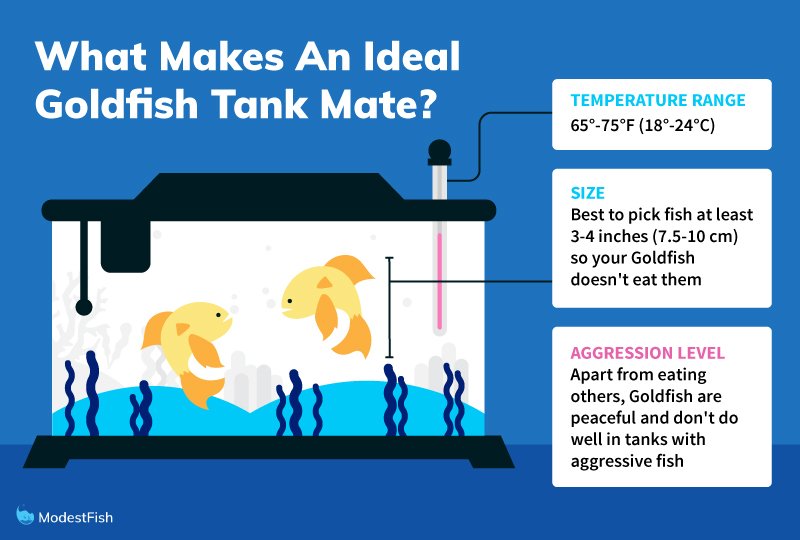
Here are the rules you need to follow when deciding on goldfish tank mates.
Live In The Same Temperature Range
You need to make sure your potential tank mate for your goldfish can live in the same temperature range.
Goldfish are classified as “cold water” fish. Technically, this term is incorrect, but it’s what most people in the hobby call temperate fish that prefer to live at a temperature range between 65° and 75°F (18°-24°C).
Most of the fish found in the aquarium trade originate from tropical areas around the world and need temperatures between 75° and 80°F (24°-27°C). Keeping them in water temperatures below 75°F could stress and kill them over time.
For example, common aquarium fish like bettas, gouramis or angelfish, need to be kept at temperatures near 80°F.
It’s critical to find fish that will thrive in the same temperature range as your goldfish.
Large Enough Not To Be Eaten
Fish are simple creatures. When they look around the tank and see other fish they’re governed by the philosophy, “If another fish can fit in my mouth, it must be food.” And the bigger a goldfish gets, the easier it is for roommates to start looking like potential snacks.
Goldfish are ALWAYS hungry. They don’t set out to be mean, but they will vacuum up anything edible they can get in their mouths, and that includes other fish in the tank, no matter how long they’ve lived together.
Your goldfish tank mate should be around 3-4 inches (7.5-10cm). This will ensure they’re not viewed as a snack.
Swimming Speed & Activity
Different types of goldfish swim at different paces. For example, a comet goldfish will zoom around at great speeds. This means you should look for tank mates who are faster swimmers and won’t be bullied or out-competed for food.
Fancy goldfish or bubble eye goldfish are much slower. This leaves them vulnerable to highly active fast swimmers, who might nip at them or steal their food.
If you really want to keep smaller fish with your goldies (for the record, this is ALWAYS risky), then you should choose species that are so fast that they can easily outswim marauding goldfish.
Just be warned, any little fish that slows down, because it’s sick or elderly, is likely to end up as lunch.
Pro Tip: You should only mix goldfish and smaller fish if you have a large tank, something like 40 gallons (151 liters) or more. This gives the smaller tank mates room to get away from hungry goldfish.
They Need A Peaceful Temperament
Despite their tendency to gulp down smaller tank mates, goldfish are considered extremely peaceful fish.
For the most part, they don’t go around nipping fins or acting aggressively.
They really can’t stick up for themselves if another fish starts to bully them. And their long trailing fins make them a target for any species of fish known for fin nipping, like tiger barbs or most tetra species.
So any species you put in a goldy tank needs to be very peaceful. Otherwise, you risk your goldfish being beat up, stressed or even killed.
They absolutely can’t be housed with aggressive species like Jack Dempseys or convict cichlids.
Which Goldfish Companion is Right For You?
When it comes to choosing goldfish tank mates, or just fish in general, your biggest consideration has to be your tank size. By themselves goldfish require a lot of room and filtration because they produce so much waste.
Add to that fish that get over 4 inches long, and have to be kept in a school of five or more and you would need an enormous tank. If you don’t have a 100 gallon (378 liter) tank, it’s best to go with a smaller species, like the banded corydoras or the giant danios.
Tank size also matters if you’re going to mix in smaller fish, like white clouds or zebra danios. You have to make sure that they have enough room to get away from hungry goldfish.
The aquarium needs to be long enough so that tiny fish can dart away from the goldy if needed. I wouldn’t recommend attempting smaller fish unless you have at least a 40 gallon (151 liters).
Be prepared to move new tank mates if it seems like they’re not going to work out. Watch out for things like fin nipping damage on your goldfish’s fins. You should also keep a count of smaller fish and remove them if some suddenly start disappearing.

Glad I could get some good advice thank u
Thanks for the information – I just moved my pond goldfish inside for the winter – found a free 90 gallon tank for them – so they will need some tank friends – thanks for your help.